Destination: Cal Delta
Habitat diversity, sprawling vastness equal unparalleled Western fishery
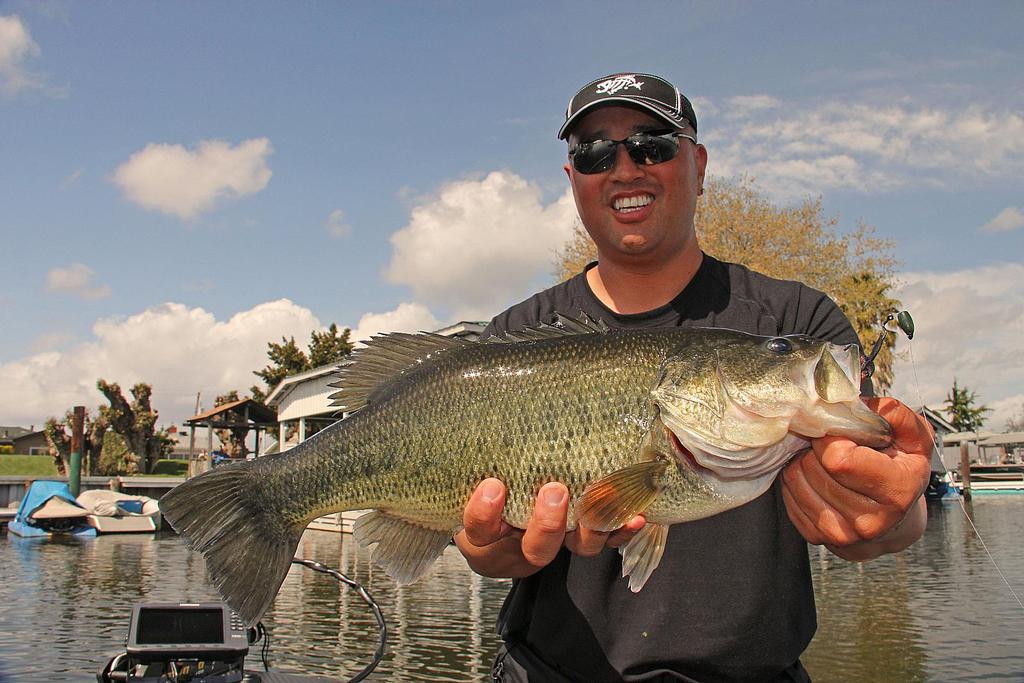
Elvis, Oprah, The Rock – apparently, one of the perks of being famous is being able to go by a single moniker. And that’s pretty much the same reason you never ask for clarification when a bass angler from virtually anywhere in the country mentions “The Delta.” It’s just understood that you’re talking about California’s Central Valley drainage/big-bass production facility.
“I think the Delta is one of the most fertile bass fisheries in the world with its abundance of crayfish, shiners, shad, bluegill, etc.,” said EverStart pro Ken Mah. “There’s so much cover, there are thousands of miles of riprap banks and heavily vegetated areas. There are a lot of options for a beginning angler or someone who likes (a certain style of fishing). The Delta will fit a lot of styles.”
Sure, there might be the occasional confusion with the Mississippi River Delta – another super fertile region lacking not for respectable largemouth bass action. However, conversations of Southeast Louisiana bass fishing usually carry more targeted references of particular marshes and bayous.
 But when you say “The Delta,” serious anglers immediately envision that forage-rich bass wonderland blessed with quantity and quality in great measure. Anchored by the convergence of the Sacramento and San Joaquin rivers, along with countless tributaries and rural streams, Delta waters comprise a labyrinthine of navigable arteries, all subject to tidal influence through their common connection to San Francisco Bay. There’s plenty of area to spread out and select your own little piece of paradise, but don’t be surprised if you find yourself overwhelmed with a dilemma borne of abundance – in other words, it all looks fishy.
But when you say “The Delta,” serious anglers immediately envision that forage-rich bass wonderland blessed with quantity and quality in great measure. Anchored by the convergence of the Sacramento and San Joaquin rivers, along with countless tributaries and rural streams, Delta waters comprise a labyrinthine of navigable arteries, all subject to tidal influence through their common connection to San Francisco Bay. There’s plenty of area to spread out and select your own little piece of paradise, but don’t be surprised if you find yourself overwhelmed with a dilemma borne of abundance – in other words, it all looks fishy.
No doubt, the Cal Delta’s sprawling acreage presents far more than we can fairly cover in a single sitting, but we can identify some of the key where-to and how-to stuff that’ll get you going in the right direction. First, though, a few points about daily considerations of a tidal environment.
Ebb and flow
For starters, while the tide can confound, perplex and frustrate, it can also assist, enable and bestow you with opportunities galore. It’s all based on the simple principle of access. As the water rises, fish tend to push deeper into cover, while falling tides pull them out to the edges. Moving water – either direction – will generally stimulate feeding, as tides wash forage through predictable routes and bass position for the feeding opportunities. (Think points, edges and funneling areas).
Understand that tides advance about an hour every day, so if you dial in a productive period today, know that this tidal stage will occur progressively later on subsequent days. For general planning purposes, various Smartphone apps or the tide function common to most modern navigational units will show you the current and coming water levels throughout the Delta. Nature offers clues, as well, so look for waterlines on docks, debris lines on rip rap and mud lines on tules – which all provide visual reference to the tide stage.
Tides are particularly important during the spawn, as bass will nest in areas that hold sufficient water through the low cycle. This means a lot more water over the fish during high tide, so “sight-fishing” often becomes more of a case of throwing to likely areas during a full tide. Also, FLW Tour pro Ish Monroe notes that bass bed shallower in dark water; deeper in clear areas.
Work with the water
The great thing about the Delta is that, given its diverse habitat of natural and manmade form, any tidal stage can prove productive. With a hot bite identified, savvy Delta anglers will often attempt to stay on that scenario by “running the tide” and advancing up or down the tidal range.
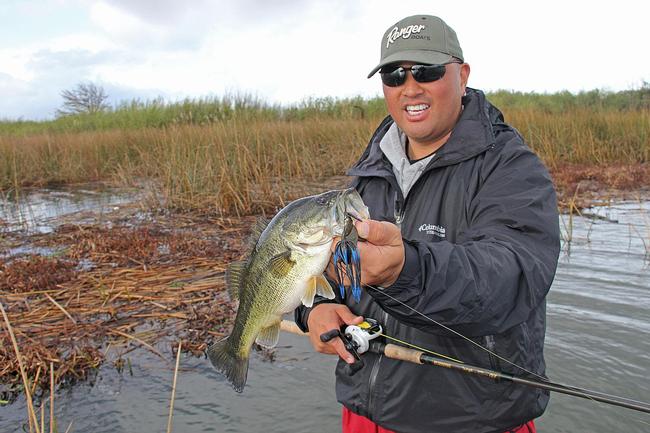 Depending on the pattern you’re running, low incoming water might be a great way to start the day. This means fish will be moving up to the edges with a predictable retreat coming later in the day once the high tide starts falling. Mah says a day that starts with high tide offers easier navigation and longer periods of opportunity.
Depending on the pattern you’re running, low incoming water might be a great way to start the day. This means fish will be moving up to the edges with a predictable retreat coming later in the day once the high tide starts falling. Mah says a day that starts with high tide offers easier navigation and longer periods of opportunity.
“It really lets me relax because I have so much water; I don’t have to rush around and check the areas that I want to check,” he said. “When I have a high tide, my windows are bigger. That doesn’t necessarily mean the fish are going to bite better; it just means that instead of having a half hour window at this area and an hour window at this area, I have more time at each area.
“On a tidal waterway like the Delta, if you spend too much time in one area, you lose the potential of fishing other areas once the water level drops or changes direction, so the windows are smaller. But on a high tide, my windows are bigger.”
California pro Zack Thompson has nothing against tide running and other water flow calculations – that’s often necessary for tournament competition. For casual Delta visitors, though, he suggests a different strategy.
“For the guy who brings his kids out here to just fish and have a good time, I’d suggest not worrying so much about moving around a lot with the tide schedule,” Thompson said. “Just break off a manageable section of the Delta and learn to fish it through all the tide stages.”
Diverse habitat
Probably the most appealing Cal Delta feature is that it offers something for every fishing style. Here’s a rundown of the general assortment.
Tules: The Delta’s most distinctive vegetation, this giant sedge sprouts from the edges of rock levees, sandy ridges and peat moss mounds. Tules grow mostly in large masses – either dense fields with narrow drains inviting exploration, sparse clumps smattering a hard line or the classic wall of green known as a “tule berm.” Note: You’ll also find the occasional band of lower, new-growth tules bordering an established line. This is prime spawning habitat, so give this perimeter habitat a close look in the spring months.
Top tule tactics include flipping jigs and soft plastics, pitching Texas-rigged Senkos, bumping the sparse stalks with spinnerbaits and probing all the gaps and nooks with a dropshot. As Thompson notes, dense tule berms may seems shallow at their root clusters, but these berms often sit just inches from a deep drop into the channel, so work all around the vegetation and let that drop-shot take the plunge to see who’s watching from below.
Grass: Over lush hydrilla beds, frogs, weedless-rigged Skinny Dippers and buzzbaits will attract attention, but a ChatterBait is one of the Delta’s deadliest, as Jim Moulton demonstrated in his EverStart win on May 18. Moulton shared a couple of ChatterBait tips: First, while the incoming tide creates more fishable area, the falling water reveals the holes where big bass settle into on the falling water. Second, he’ll double hook his ChatterBait trailer (through the head, then back into the body) for a more secure fit that resists pull-downs on missed strikes. Also, Moulton says, those isolated grass clumps often hold one big fish, so give the loners a couple of casts.
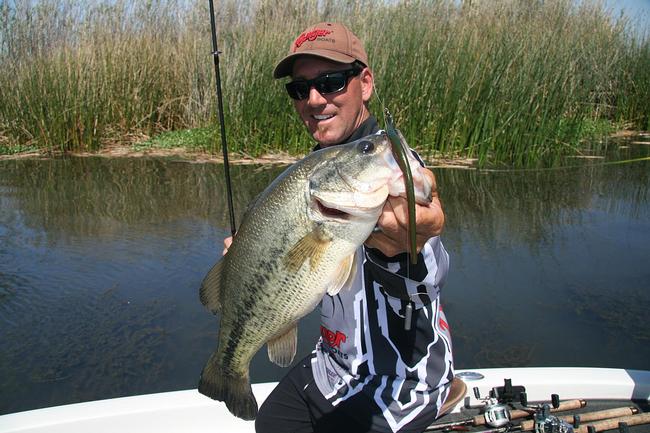 For grass duty, northern Cal pro Jeff Michels notes the strong potential of blended habitat – specifically, clumps of hydrilla interspersed with scattered tules. Wacky-rigged Senkos get the call most of the time here and Michels uses a heavy wire circle hook with a durable fiber weed guard and opens up the hook to create a wider gap for optimal Senko connections.
For grass duty, northern Cal pro Jeff Michels notes the strong potential of blended habitat – specifically, clumps of hydrilla interspersed with scattered tules. Wacky-rigged Senkos get the call most of the time here and Michels uses a heavy wire circle hook with a durable fiber weed guard and opens up the hook to create a wider gap for optimal Senko connections.
In another blended scenario, grass lines buttressing tule berms often create a gap or corridor between the two and that’s prime spawning habitat. In 2011, Sean Minderman won a Delta EverStart event by targeting spawners he had located in specific little corridors between the tules and adjacent hydrilla. (Look for pre-spawners to stage on the outside grass edges.)
Just about any time but winter, running a swimbait along a grass edge is a good bet for a big explosion. In many scenarios, Mah said spawners will crush a 7- to 9-inch swimmer ambling past their shallow grass flat.
“Those big ones have a hard time ignoring the big slow-moving easy meal,” he said.
Weed mats: Sometimes it’s a well-defined accumulation of pennywort, but more commonly, it’s those hodgepodge conglomerations of floating weeds mingled with anchored hydrilla, topped with planks of dead tules and sprinkled with random flotsam that hold the big, nasty toads.
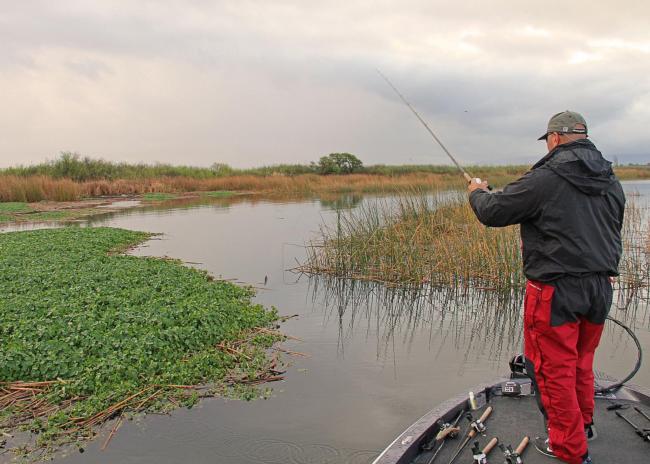 Punching beaver-style baits with 1- to 2-ounce weights stimulates reaction bites from fish lounging in the shadows. Some dress their baits with skirts like the Paycheck Baits Punch Skirt, developed in the Delta by local EverStart pro Bub Tosh. Strike King’s Slither Rig offers an all-in-one option with a skirt affixed to a tungsten weight. Whatever your choice, pegging your weight with a rubber stopper ensures your weight and bait stick together as they pass through the dense salad.
Punching beaver-style baits with 1- to 2-ounce weights stimulates reaction bites from fish lounging in the shadows. Some dress their baits with skirts like the Paycheck Baits Punch Skirt, developed in the Delta by local EverStart pro Bub Tosh. Strike King’s Slither Rig offers an all-in-one option with a skirt affixed to a tungsten weight. Whatever your choice, pegging your weight with a rubber stopper ensures your weight and bait stick together as they pass through the dense salad.
Mah also offers this tip: High-visibility braided line helps him closely monitor his line for the slight twitch of a subtle bite, but he doesn’t want this bright appearance spooking the fish. His solution – darken the last 6 feet of the braid with a black permanent marker. This also removes any guesswork, as the dark section provides a depth indicator as well.
Riprap: Rock levees protecting adjacent terra firma present classic bass habitat, particularly during pre-spawn when rocks skirted by emerging hydrilla make handy staging zones. Cover long stretches quickly with lipless or squarebill crankbaits and flip active areas with jigs or creature baits. Multiple opportunities await when wind-blown weed mats rest against the boundary of riprap and tules.
Marinas: Docks, boat houses and all the usual manmade structure abounds throughout the Delta, so don’t miss the chance to flip a jig or Texas-rigged craw around the hard stuff or skip a shaky head worm into the shadows. Thompson looks for weed mats blown into dock structure. There he’ll punch a compact bait like the Berkley Havoc Pit Boss.
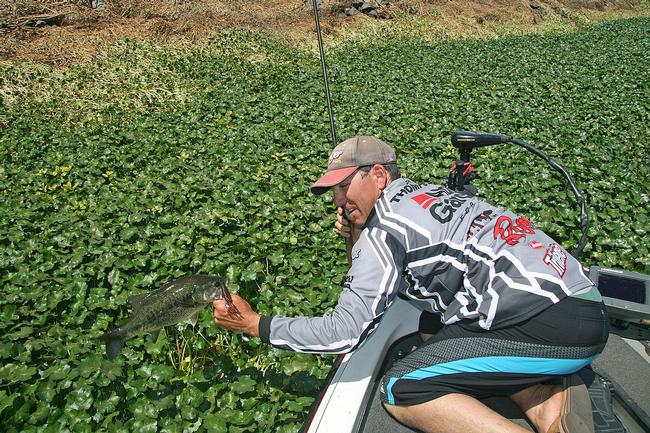 Clearly, the Cal Delta presents a potentially mind-blowing premise of vast opportunity complicated by tide-based time restraints. However, experienced “Delta rats” know that this heralded big bass factory can be whittled down to a handful of particular scenarios that provide the outline for a tremendous day of fishing. Learn the basics of daily tide cycles, pay close attention to conditions and catch details, and before you know it, you’ll be on your way to mastering this premier western fishery.
Clearly, the Cal Delta presents a potentially mind-blowing premise of vast opportunity complicated by tide-based time restraints. However, experienced “Delta rats” know that this heralded big bass factory can be whittled down to a handful of particular scenarios that provide the outline for a tremendous day of fishing. Learn the basics of daily tide cycles, pay close attention to conditions and catch details, and before you know it, you’ll be on your way to mastering this premier western fishery.